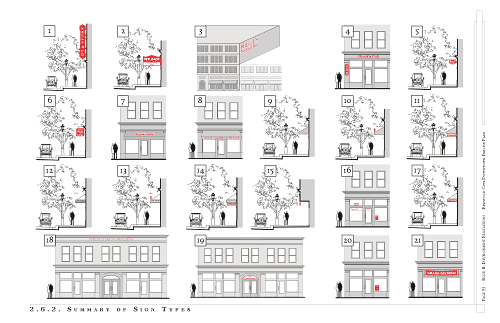This wonderful drawing is from the Downtown Precise Plan of Redwood City, California. It show 21 signage types that are commonly encountered in pedestrian-oriented, mixed-use frontages, streets and districts.
The drawings are by Dan Zack, project manager of the city’s community development department. The layout is by Freedman Tung & Bottomley, lead urban design consultant for the Precise Plan.
In the extended entry, a key to this drawing with short definitions of each sign type from the Downtown Precise Plan.
Key to the “Summary of Sign Types”
1) Grand Projecting Sign
Grand Projecting Signs are tall, large, vertically oriented signs which project from
the building perpendicular to the facade and which are structurally integrated
into the building.
2) Marquee Sign
Marquee Signs are large, canopy-like structures mounted over the entrance to a
theater.
3) Grand Wall Sign
Grand Wall Signs are large signs located on, and parallel to, large unfenestrated
building wall areas.
4) Wall Sign
Wall Signs are signs which are located on, and parallel to, a building wall.
5) Blade Sign
Blade Signs are signs which are oriented perpendicularly to the building facade
and which are suspended under a bracket, armature, or other mounting device.
6) Projecting Sign
Projecting Signs are cantilevered signs which are structurally affixed to the
building and oriented perpendicularly to the building facade.
7) Awning Face Sign
Awning Face Signs are signs applied to the primary face of an awning, including
sloped awning faces and vertical “box” awning faces.
8) Awning Valance Sign
Awning Valance Signs are signs applied to the awning valence.
9) Awning Side Sign
Awning Side Signs are signs applied to the side panel of an awning.
10) Above Awning Sign
Above Awning Signs are signs which are mounted partially or entirely above the
upper edge of a valance of an awning and oriented parallel to the building wall
surface.
11) Under Awning Sign
Under Awning Signs are signs which are suspended under an awning, perpendicular to the building facade.
12) Canopy Fascia Sign
Canopy Fascia Signs are signs which are mounted to the front or side fascia of a
canopy and contained completely within that fascia.
13) Above Canopy Sign
Above Canopy Signs are signs which are mounted partially or entirely above the
front fascia of a canopy and oriented parallel to the building wall surface.
14) Under Canopy Sign
Under Canopy Signs are signs which are suspended under a canopy, perpendicular
to the building facade.
15) Recessed Entry Sign
Recessed Entry Signs are signs which are oriented parallel to the building facade
and which are suspended over a recessed entry.
16) Window Sign
Window Signs are signs which are applied directly to a window or mounted or
suspended directly behind a window.
17) Building Identification Canopy Fascia Sign
Building Identification Canopy Fascia Signs are signs which are mounted to
the front or side fascia of a canopy, contained completely within that fascia and
oriented parallel to the building wall surface and which announce the name of
a building.
18) Building Identification Wall Sign
Building Identification Wall Signs are signs located on, and parallel to a building
wall which announce the name of a building.
19) Building Identification Window Sign
Building Identification Window Signs are signs applied directly to a window or
mounted or suspended directly behind a window.
20) Temporary Window Sign
Temporary Window Signs are signs which are applied directly to a window or
mounted or suspended directly behind a window and are designed, constructed
and intended for display on private property for a period of not more than ninety
(90) consecutive days per year. Examples include “grand opening,” “special sale,” and seasonal signage.
21) Temporary Wall Sign
Temporary Wall Signs which are located on, and parallel to, a building wall and
are designed, constructed, and intended for display on private property for a
period of not more than ninety (90) consecutive days per year. Examples include “grand opening,” “special sale,” and seasonal temporary banner signage.
Resources
“Section 2.6.2. Sign Type Standards & Guidelines,” from pages 92-101 of Book II: Development Regulations of the Redwood City Downtown Precise Plan. May 2007.
Redwood City’s signage typology is a good complement to the D.C. Office of Planning booklet, Thrive: A Guide to Storefront Design in the District of Columbia (2002), by Derrick Lanardo Woody. See the blog post The Anatomy of DC Storefronts for more details.


This is a great resource for those of us designing for new independent retailers. Many Thanks for the resource.